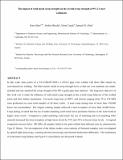The Impact of Weld Metal Creep Strength on the Overall Creep Strength of 9% Cr Steel Weldments
Author(s)
Mayr, Peter; Mitsche, Stefan; Cerjak, Horst; Allen, Samuel Miller
Downloadoriginal manuscript (12.03Mb)
OPEN_ACCESS_POLICY
Open Access Policy
Creative Commons Attribution-Noncommercial-Share Alike
Terms of use
Metadata
Show full item recordAbstract
In this work, three joints of a X11CrMoWVNb9-1-1 (P911) pipe were welded with three filler metals by conventional arc welding. The filler metals varied in creep strength level, so that one overmatched, one undermatched, and one matched the creep strength of the P911 grade pipe base material. The long-term objective of this work was to study the influence of weld metal creep strength on the overall creep behavior of the welded joints and their failure mechanism. Uniaxial creep tests at 600°C and stresses ranging from 70 MPa to 150 MPa were performed on the cross-weld samples of all three welds. A total creep testing time of more than 470,000 h was accumulated. The longest running sample achieved a time-to-rupture of more than 45,000 h. Creep testing revealed that the use of undermatching weld metal led to a premature fracture in the weld metal at higher stress levels. Compared with undermatching weld metal, the use of matching and overmatching filler materials increased the time-to-rupture at high stress levels by 75% and 33% at lowest stress levels. At typical component stresses below 100 MPa, all samples failed in the grain-refined heat-affected zone by characteristic type IV failure. For investigations of the failure modes, cross sections of fractured samples were investigated by optical light microscopy, scanning electron microscopy, and electron backscatter diffraction. The mechanism of weld metal creep failures and type IV creep failures is discussed in detail.
Date issued
2011-03Department
Massachusetts Institute of Technology. Department of Materials Science and EngineeringJournal
Journal of Engineering Materials and Technology
Publisher
ASME International
Citation
Mayr, Peter, Stefan Mitsche, Horst Cerjak, and Samuel M. Allen. “The Impact of Weld Metal Creep Strength on the Overall Creep Strength of 9% Cr Steel Weldments.” Journal of Engineering Materials and Technology 133, no. 2 (2011): 021011.
Version: Author's final manuscript
ISSN
00944289